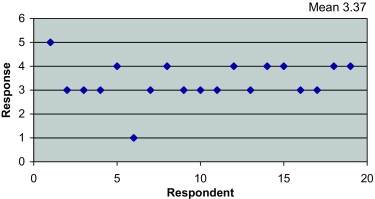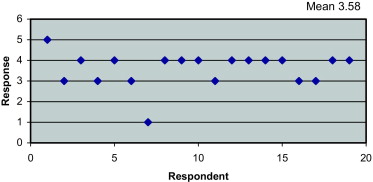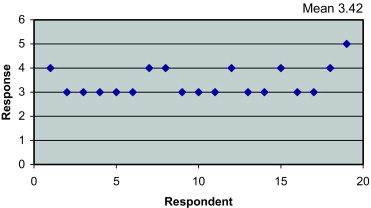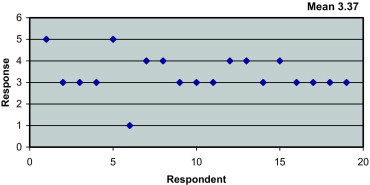The adage “To teach is to learn twice” (Joseph Joubert, 1754–1824) is an often-quoted phrase that captures the essence of why teaching is considered a powerful method of learning. Although resident teaching activities have historically been an integral component of residency training in clinically based specialties such as internal medicine and surgery, they have played a much smaller role in radiology residency programs and are generally less formal. Indeed, many radiology residency programs do not offer any formal teaching opportunities. It is thus not surprising that relatively little has been published in the radiology literature on the perceived benefits of a resident-as-teacher program on participating resident-teachers and an audience of learners ( ).
In 2004, our radiology department developed and implemented a monthly case-based resident-as-teacher program entitled “chief’s rounds” with the combined goals of enhancing resident teaching and presentation skills and increasing resident interest in following up cases encountered in daily practice. In 2006, we sought to determine the impact of this program on resident-teachers and on a diverse audience comprising residents, faculty, technologists, and nurses. Specifically, we surveyed participating residents about the impact of participation on resident teaching and presentation skills, interest in teaching, and frequency with which they follow-up or read about cases encountered in daily clinical practice. We also used surveys to determine the perceived impact of the educational value of these monthly conferences as compared to our department’s more traditional weekly grand round lecture offerings. In this article, we describe the results of these surveys and discuss the potential benefits of a case-based, resident-teacher program on participating residents and a diverse audience of learners.
Methods
Chief’s Rounds Background
Chief’s rounds are case-based, didactic conferences held monthly as part of our traditional weekly departmental grand rounds series. For each chief’s rounds session, 8 to 10 residents from all years of training are assigned on a rotating basis to prepare individual 7-minute presentations of interesting cases that they have encountered during their most recent rotation. Each case presentation follows a defined format and includes a brief clinical history, a description of the imaging findings, a discussion of the differential diagnosis, followed by a brief review of the salient clinical, radiologic, and pathologic features of the final diagnosis. Many presentations include illustrative companion cases and radiologic-pathologic correlation.
Before the presentation, each resident is encouraged to review his or her case and presentation with an attending radiologist with expertise in the organ system related to the presentation. After the presentations have been finalized, the cases are submitted to the chief resident, who moderates the session and adds additional teaching points between cases when appropriate.
Departmental Grand Rounds Background
Our department conducts weekly grand rounds from September through June each year. The grand round program includes weekly lectures by visiting and departmental faculty that are interspersed between monthly quality assurance conferences and monthly chief’s rounds presentations. Attendees for all grand rounds events (including chief’s rounds) include radiology residents, fellows, faculty, nurses, and technologists from all sections in our department, as well as medical students.
After each grand rounds, an e-mail is sent to all departmental members with a link to complete an anonymous electronic survey of the program. The survey is shown in Appendix 1 and consists of eight questions graded on a four-point Likert scale (1, strongly disagree; 2, disagree; 3, agree; 4, strongly agree; and not applicable) assessing content, delivery, relevance, and suitability of the format for learning new material, as well as two free text questions soliciting general comments and suggestions for future speakers and topics. The same survey instrument was sent to attendees of traditional grand rounds offerings and chief’s rounds.
Get Radiology Tree app to read full this article<
Get Radiology Tree app to read full this article<
Survey of Participating Resident-Teachers
Get Radiology Tree app to read full this article<
Get Radiology Tree app to read full this article<
Get Radiology Tree app to read full this article<
Data Analysis
Get Radiology Tree app to read full this article<
Get Radiology Tree app to read full this article<
Get Radiology Tree app to read full this article<
Results
Perceived Impact of Participation by Resident-Teachers
Get Radiology Tree app to read full this article<
Get Radiology Tree app to read full this article<
Get Radiology Tree app to read full this article<
Get Radiology Tree app to read full this article<
Get Radiology Tree app to read full this article<
Comparison between Chief’s Rounds and Faculty-Led Grand Rounds
Get Radiology Tree app to read full this article<
Table 1
Grand Rounds Survey Data Comparing General Grand Round Offerings with Chief’s Rounds Presentations
Survey Question Grand Rounds Mean Chief’s Rounds Mean_P_ Value The presentation met the objectives 3.55 3.70 .0002 The content was relevant 3.57 3.72 .0002 The delivery of the talk maintained your interest 3.51 3.69 <.0001 The topic was of interest to you 3.50 3.72 <.0001 The mix of basic science and clinical information seemed appropriate 3.36 3.51 .0041 There was a practical application 3.54 3.68 .0007 The presentation stimulated thinking 3.51 3.63 .0045 The format was helpful in learning new material 3.45 3.68 <.0001
Get Radiology Tree app to read full this article<
Get Radiology Tree app to read full this article<
Get Radiology Tree app to read full this article<
Discussion
Get Radiology Tree app to read full this article<
Get Radiology Tree app to read full this article<
Get Radiology Tree app to read full this article<
Get Radiology Tree app to read full this article<
Get Radiology Tree app to read full this article<
Get Radiology Tree app to read full this article<
Get Radiology Tree app to read full this article<
Get Radiology Tree app to read full this article<
Get Radiology Tree app to read full this article<
Appendix 1
Get Radiology Tree app to read full this article<
Appendix 2
Chief’s Rounds Survey
Get Radiology Tree app to read full this article<
Get Radiology Tree app to read full this article<
Get Radiology Tree app to read full this article<
Get Radiology Tree app to read full this article<
Get Radiology Tree app to read full this article<
Get Radiology Tree app to read full this article<
Get Radiology Tree app to read full this article<
Get Radiology Tree app to read full this article<
Get Radiology Tree app to read full this article<
Get Radiology Tree app to read full this article<
Get Radiology Tree app to read full this article<
Get Radiology Tree app to read full this article<
Get Radiology Tree app to read full this article<
Get Radiology Tree app to read full this article<
Get Radiology Tree app to read full this article<
Get Radiology Tree app to read full this article<
Get Radiology Tree app to read full this article<
Get Radiology Tree app to read full this article<
Get Radiology Tree app to read full this article<
Get Radiology Tree app to read full this article<
References
1. Collins J., Miller S.S., Albanese M.A.: Resident learning and knowledge retention from resident-prepared chest radiology conferences. Acad Radiol 1997; 4: pp. 732-735.
2. Maniero M.B., Collins J., Primack S.L.: Effectiveness of resident-prepared conferences in teaching imaging utilization guidelines to radiology residents. Acad Radiol 1999; 6: pp. 748-751.
3. Roberts C.C., Chew F.S.: Teaching radiology residents and radiology residents as teachers. Acad Radiol 2003; 10: pp. S97-S101.
4. Chew F.S.: The case-based radiology teaching conference for residents: beneficial effect of previewing cases and using answer sheets. Acad Radiol 2001; 8: pp. 993-997.
5. Wilson F.C.: Residents as teachers. J Bone Joint Surg Am 2001; 83A: pp. 1441-1443.
6. Bensinger L.D., Meah Y.S., Smith L.G.: Resident as teacher: the Mount Sinai experience and a review of the literature. Mount Sinai J of Med 2005; 72: pp. 307-311.
7. Wamsley M.A., Julian K.A., Wipf J.E.: A literature review of “resident-as-teacher” curricula. JGIM 2004; 19: pp. 574-581.
8. Weiss V., Needlman R.: To teach is to learn twice: resident teachers learn more. Arch Pediatr Adolesc Med 1998; 152: pp. 190-192.



